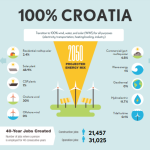ZAGREB, July 20, 2018 – Croatia’s performance in the implementation of energy efficiency programmes can be compared with the success of the national football team at the World Cup in Russia, according to the article headlined “Croatia’s renovation projects can teach us as much as their football” which the EurActiv web portal has recently published.
“Croatia’s achievement in advancing the energy efficiency revolution is a beacon that should be celebrated, just as we have been thrilled by their triumphs on the football pitch,” says the author of the article, Adrian Joyce, an expert for energy efficiency and the director of the Renovate Europe campaign.
“We know that we need to sharply accelerate our pace of building renovations to meet the climate promises made in Paris, and the question of how exactly to do this has been giving energy experts sleepless nights. Enter Croatia. The west Balkan state is currently in the throes of an energy renovation overhaul which will see 411 million euro of structural funds invested by 2020, much of it through energy service companies (ESCO’s).”
“Already, between 2014 and 2016, a 220 million euro energy renovations programme benefitted more than 15,600 family homes, 2,300 multi-unit buildings, 80 commercial buildings and 262 public buildings,” reads the article.
Joyce points out the example of the Karlovac Hospital building as one of success stories. “That hospital has been transformed after a 7.2 million euro investment and four months of remedial work – with minimal disruption to patients and staff. Its yearly CO2 emissions have been more than halved – the climate mitigation equivalent of planting 113,000 more trees. Annual heating savings are also expected to be above 50%, as are annual financial savings.”
The article reads that the cost of the deep refurbishment should be paid off within 14 years, “from the savings on energy bills brought by the renovation works. These include the installation of new heat pumps, cooling systems, solar thermal collectors and a 25% renewable energy supply.”
Joyce says that “the public-private partnership behind the makeover worked with an ESCO mobilising 60% of the finances from private investors and 40% from the Croatian energy efficiency fund.”
“Altogether, around 250 workers were employed on the build, with 32 mostly nearby companies, giving a boost to the local economy.”
“Compared to traditional public procurement practice, renovation contracts in Croatia are simpler, standardised and more transparent. They have been completed up to seven times faster and with significantly lower administrative and total costs,” Jouyce writes.
“That is because the relevant investments have been tightly codified. They must guarantee minimum energy savings of 50%, and no new costs for public budgets. And they have to take the form of energy performance contracts, negotiated in an open public procurement tendering process.
“Energy refurbishment programmes have been applied to Croatia’s high-rise buildings, to private homes and commercial buildings. A guarantee scheme for ESCO’s similar to the one set up in Bulgaria may be the next step. As with the national teams occasionally erratic defending, there is room for improvement in Croatia’s energy renovation picture too,” he says.
“Mistrust of banks remains a problem, although it is improving. The Croatian Bank for Reconstruction and Development, for example, has recently begun extending credit lines for energy efficiency projects on extremely favourable terms. Perhaps the biggest concern for the country’s investors is the lack of continuity in EU funding for efficiency projects, which very often become a de facto hostage to budgetary decisions in Brussels, and in national capitals,” reads the article.
“The result is a ‘Stop-Go’ dynamic that denies businesses and investors the certainty they need to effectively plan ahead. “Around 3,000 construction jobs may have been created in Croatia over a two-year period, but it is also true that many construction workers have left the country because of the unpredictability that hangs over their future employment prospects.








